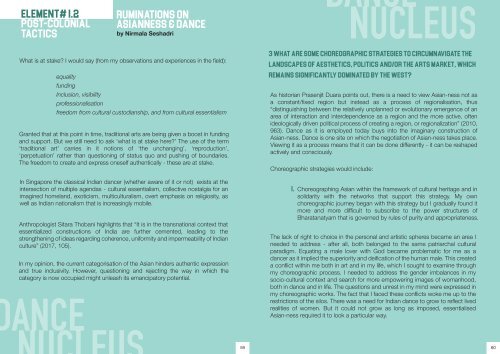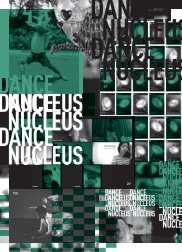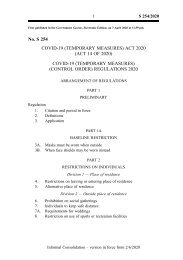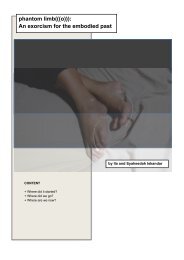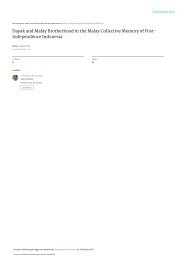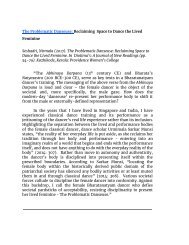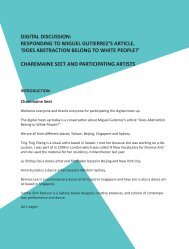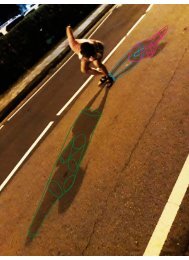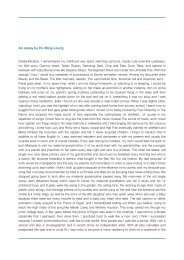FUSE#1
FUSE is a bi-annual publication that documents the projects at Dance Nucleus
FUSE is a bi-annual publication that documents the projects at Dance Nucleus
Create successful ePaper yourself
Turn your PDF publications into a flip-book with our unique Google optimized e-Paper software.
Element# 1.2<br />
Post-Colonial<br />
Tactics<br />
Ruminations on<br />
asiaNness & Dance<br />
by Nirmala Seshadri<br />
What is at stake? I would say (from my observations and experiences in the field):<br />
equality<br />
funding<br />
Inclusion, visibility<br />
professionalisation<br />
freedom from cultural custodianship, and from cultural essentialism<br />
Granted that at this point in time, traditional arts are being given a boost in funding<br />
and support. But we still need to ask ‘what is at stake here?’ The use of the term<br />
‘traditional art’ carries in it notions of ‘the unchanging’, ‘reproduction’,<br />
‘perpetuation’ rather than questioning of status quo and pushing of boundaries.<br />
The freedom to create and express oneself authentically - these are at stake.<br />
In Singapore the classical Indian dancer (whether aware of it or not) exists at the<br />
intersection of multiple agendas - cultural essentialism, collective nostalgia for an<br />
imagined homeland, exoticism, multiculturalism, overt emphasis on religiosity, as<br />
well as Indian nationalism that is increasingly mobile.<br />
Anthropologist Sitara Thobani highlights that “It is in the transnational context that<br />
essentialized constructions of India are further cemented, leading to the<br />
strengthening of ideas regarding coherence, uniformity and impermeability of Indian<br />
culture” (2017, 105).<br />
In my opinion, the current categorisation of the Asian hinders authentic expression<br />
and true inclusivity. However, questioning and rejecting the way in which the<br />
category is now occupied might unleash its emancipatory potential.<br />
3 What are some choreographic strategies to circumnavigate the<br />
landscapes of aesthetics, politics and/or the arts market, which<br />
remains significantly dominated by the West?<br />
As historian Prasenjit Duara points out, there is a need to view Asian-ness not as<br />
a constant/fixed region but instead as a process of regionalisation, thus<br />
“distinguishing between the relatively unplanned or evolutionary emergence of an<br />
area of interaction and interdependence as a region and the more active, often<br />
ideologically driven political process of creating a region, or regionalization” (2010,<br />
963). Dance as it is employed today buys into the imaginary construction of<br />
Asian-ness. Dance is one site on which the negotiation of Asian-ness takes place.<br />
Viewing it as a process means that it can be done differently - it can be reshaped<br />
actively and consciously.<br />
Choreographic strategies would include:<br />
1.<br />
Choreographing Asian within the framework of cultural heritage and in<br />
solidarity with the networks that support this strategy. My own<br />
choreographic journey began with this strategy but I gradually found it<br />
more and more difficult to subscribe to the power structures of<br />
Bharatanatyam that is governed by rules of purity and appropriateness.<br />
The lack of right to choice in the personal and artistic spheres became an area I<br />
needed to address - after all, both belonged to the same patriarchal cultural<br />
paradigm. Equating a male lover with God became problematic for me as a<br />
dancer as it implied the superiority and deification of the human male. This created<br />
a conflict within me both in art and in my life, which I sought to examine through<br />
my choreographic process. I needed to address the gender imbalances in my<br />
socio-cultural context and search for more empowering images of womanhood,<br />
both in dance and in life. The questions and unrest in my mind were expressed in<br />
my choreographic works. The fact that I faced these conflicts woke me up to the<br />
restrictions of the silos. There was a need for Indian dance to grow to reflect lived<br />
realities of women. But it could not grow as long as imposed, essentialised<br />
Asian-ness required it to look a particular way.<br />
59 60


